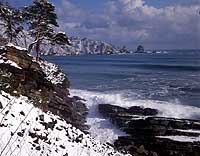
| Pseudonym reading | Tanoha no Haekasekuki Sanchi |
|---|---|
| Specified type | Prefecture designation |
| Type | Natural monuments and geological minerals |
| Designated date | March 8, 1966 |
| Specified details | |
| quantity | |
| location | Tanohata village large character Tanobata |
| owner | Outside the individual |
| Holding group | |
| Management organization | |
| home page |
Overview
Cretaceous (70, 000 to 13, 500 years ago) strata distributed in Miyako style (Miyako layer) are distributed on the northern land Naka shore such as Tanohata village, Iwaizumicho Shigeshi, Miyako city, Miyako city. ing.
The Miyako Formation is divided sequentially from the bottom into the Laga rock formation, the Shigeru sandstone formation, the Orbitrina sandstone formation, and the Akoto sandstone formation, and from the formations other than the Laga rock formation, bivalves such as triangular shellfish (trigonias), snails, kikuishi ( Ammonites), meteorites and other cephalopods, corals, and orbitrina (a kind of foraminifera) are produced.
Among the coasts of Tanohata village, the small peninsula part called Heipe-Koikorobe especially contains a large number of fossils and is rich in species and population, as a marker of the Miyako layer, and as a producing district of its standard fossils. Scientifically very valuable.
